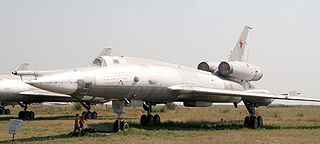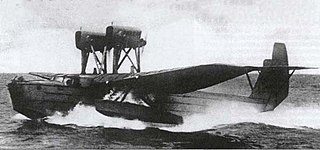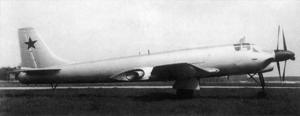Development
Following the end of World War II in 1945, Stalin ordered an aggressive naval expansion to counter the American naval superiority. The expansion called for building a large number of warships oriented around battleships and other heavy ships, with aircraft carriers limited to a supporting role, despite Admiral of the Fleet Nikolai Kuznetsov, Commander-in-chief of the Soviet Navy, pushing for carriers. Stalin restored him to command of the navy in 1951, after having demoted him four years before, and Kuznetsov attempted to persuade him of the value of the carrier in 1952, but Stalin refused to make a decision before his death the following year. [2]
Kuznetsov had ordered preliminary design work to begin on the Project 85 light aircraft carrier and the aircraft for the ship before Stalin's death, although the ship was never more than a paper design. [3] This allowed the Tupolev Design bureau to decide upon on a single-engined turboprop aircraft to meet Soviet Naval Aviation's requirement for a long-range strike aircraft, capable of attacking targets with bombs or torpedoes. [4] The new leaders of the Soviet Union rejected proposals for carriers [1] and the Council of Ministers issued a requirement for a land-based bomber powered by a Kuznetsov TV-2 turboprop engine that was capable of level and dive bombing attacks on targets with bombs, torpedoes, rockets, gunfire and naval mines, in addition to coastal reconnaissance missions, on 29 April 1953. [5] This forced the bureau to revise the design to eliminate the wing-folding mechanism, arresting gear and other carrier-specific equipment for the second prototype. [6]
The Tu-91 first flew on 17 May 1955, [4] when the manufacturer's flight testing began. They concluded successfully about September with the test pilots concluding that the aircraft was highly manoeuverable, although barrel rolls should be forbidden. The aircraft also passed the subsequent state testing and the design bureau began preparing for production at Factory No. 31, in Tbilisi, Georgia. [Note 1] The Tu-91 was part of a display of the latest military aircraft for the Soviet leadership in mid-1956, one of the very few propeller-driven aircraft present. When the newly elected Khrushchev inquired about the aircraft, the officer detailed to the aircraft misspoke, stating that it could do the job of a heavy cruiser rather than it had the firepower of that ship. Khrushchev replied, "But nobody needs heavy cruisers any more", and commented how ridiculous it looked. This off-hand comment caused the program to be cancelled. [6] [8]
Description
The Tu-91 was a duralumin low-winged monoplane with dihedral wings built from three spars. The wing consisted of three sections, two outer panels and the center section that housed four fuel tanks and the tricycle landing gear. Control surfaces on the outer panels consisted of manually tabbed ailerons and slotted flaps. The aircraft had a conventional tail structure with vertical and horizontal stabilisers. The engine was mounted mid-fuselage above the wing spars, driving a six-bladed contra-rotating propeller in the nose via a long shaft that passed through the cockpit. Providing sufficient air to the engine required a lot of development time that eventually included replacing an engine on a Tupolev Tu-4LL flying testbed with a mockup of the Tu-91's nose with a working TV-2 installation. The solution adopted consisted of three air intakes: a chin inlet and two cheek inlets below the cockpit that met in a plenum chamber forward of the engine. The engine exhausted through a bifurcated exhaust duct that exited the sides of the fuselage aft of the wing. [6]
The crew of two sat side by side in a cockpit in the aircraft's nose, enclosed in an armour "bathtub" that consisted of 8-to-18-millimetre (0.3 to 0.7 in) ANBA-1 light alloy armour. All of the panels in the two canopies were bulletproof except for those directly overhead. In addition to the forward fuel tanks, there were another pair of tanks located between the exhaust ducts, all of which self sealing and filled with inert gases. The internal armament of the Tu-91 consisted of a pair of 23 mm (0.91 in) NR-23 cannon located in the wing roots and another pair of NR-23s in a DK-15 powered tail turret that were remotely controlled by the aircraft's navigator using a periscopic gunsight mounted externally above the cockpit. The aircraft could be fitted with five plyons, one under the fuselage and the others under the wings. These could carry a single torpedo or various bombs, rockets and mines up to a total weight of 1,500 kilograms (3,300 lb). Two of the wing pylons were plumbed to carry drop tanks in addition to weapons. A camera was fitted in the rear fuselage for reconnaissance missions. [9]

The Tupolev Tu-126 was an airborne early warning and control aircraft developed from the Tupolev Tu-114 airliner by the Tupolev design bureau. It was in service with the armed forces of the Soviet Union from 1965 to 1984.

The Tupolev Tu-4 is a piston-engined Soviet strategic bomber that served the Soviet Air Force from the late 1940s to mid-1960s. The aircraft was a copy of the American Boeing B-29 Superfortress, having been reverse-engineered from seized aircraft that had made emergency landings in the USSR.

The Tupolev Tu-85 was a Soviet prototype strategic bomber based on the Tu-4, an unlicensed, reverse engineered copy of the Boeing B-29 Superfortress. It was the ultimate development of the B-29 family, being over 50% heavier than its progenitor and had nearly double the range. Only two prototypes were built before the program was cancelled in favor of the turboprop powered Tupolev Tu-95 bomber which could cover the same range at a far higher speed.

The Tupolev Tu-80 was a Soviet prototype for a longer-ranged version of the Tupolev Tu-4 bomber, an unlicensed, reverse engineered copy of the Boeing B-29 Superfortress. It was cancelled in 1949 in favor of the Tupolev Tu-85 program which offered even more range. The sole prototype was used in various test programs before finally being used as a target.
The Tupolev Tu-70 was a Soviet passenger variant of the Tu-4 bomber, an unlicensed, reverse engineered copy of the Boeing B-29 Superfortress. Designed immediately after the end of World War II, it used a number of components from Boeing B-29s that had made emergency landings in the Soviet Union after bombing Japan. It had the first pressurized fuselage in the Soviet Union and first flew on 27 November 1946. The aircraft was successfully tested, recommended for serial production, but ultimately not produced because of more pressing military orders and because Aeroflot had no requirement for such an aircraft. A military cargo aircraft version was the Tupolev Tu-75.

The Tupolev Tu-22 was the first supersonic bomber to enter production in the Soviet Union. Manufactured by Tupolev, the Tu-22 entered service with Long-Range Aviation and Soviet Naval Aviation in the 1960s.

The Tupolev Tu-98 was a prototype swept wing jet bomber developed by Tupolev for the Soviet Union.

The Tupolev Tu-14, was a Soviet twinjet light bomber derived from the Tupolev '73', the failed competitor to the Ilyushin Il-28 'Beagle'. It was used as a torpedo bomber by the mine-torpedo regiments of Soviet Naval Aviation between 1952–1959 and exported to the People's Republic of China.
The Tupolev ANT-7, known by the VVS as the Tupolev R-6, was a reconnaissance aircraft and escort fighter of the Soviet Union. The R-6 traces its roots back to early 1928 when the Soviet Air Force needed a long-range multirole aircraft. The requirements were that it could be used for long-range transport, defensive patrolling, reconnaissance, light bombing and torpedo attack.

The Tupolev TB-1 was a Soviet bomber aircraft, an angular monoplane that served as the backbone of the Soviet bomber force for many years, and was the first large all-metal aircraft built in the Soviet Union.

The Tupolev TB-3, OKB designation ANT-6, was a monoplane heavy bomber deployed by the Soviet Air Force in the 1930s and used during the early years of World War II. It was one of the world's first cantilever wing four-engine heavy bombers. Despite obsolescence and being officially withdrawn from service in 1939, the TB-3 performed bomber and transport duties throughout much of World War II. The TB-3 also saw combat as a Zveno project fighter mothership and as a light tank transport.

The ANT-8 was an experimental flying boat designed by Tupolev. It was designated the "MDR-2" by the military.

The Tupolev Tu-12 was an experimental Soviet jet-powered medium bomber developed from the successful piston-engined Tupolev Tu-2 bomber after the end of World War II. It was designed as an interim aircraft to familiarize Tupolev and the Soviet Air Forces (VVS) with the issues involved with jet-engined bombers.

The Tupolev MTB-2, also known as the ANT-44, was a Soviet four-engine flying boat built in the late 1930s. Two prototypes were built; performance was satisfactory, but the design was overtaken by the fielding of long-range, land-based bombers by Soviet Naval Aviation and cancelled in 1940.

The Tupolev ANT-35 was a 1930s Soviet twin-engined light transport monoplane that entered service with Aeroflot in 1937 as the Tupolev PS-35.

The Tupolev Tu-82 was a 1940s Soviet experimental swept-wing bomber. It was the first Soviet jet bomber with swept wings.

The Tupolev I-14 was a Soviet fighter aircraft of the 1930s. It was a single-engined, single-seat monoplane with retractable undercarriage, designed to carry heavy armament, and as such was one of the most advanced fighters of its time. It was ordered into production, but this was cancelled after only a small number had been built, the competing Polikarpov I-16 being preferred.
The Tupolev ANT-21 was a Soviet twin-engined four-seat heavy fighter, which also had the designation MI-3. It was not accepted for production, only two prototypes being built.
The Tupolev ANT-41 was a prototype Soviet twin-engined torpedo-bomber of the 1930s. A single prototype was built, which was destroyed in a crash. No production followed, with the Ilyushin DB-3 serving as a torpedo bomber instead.

The Tupolev '73',, was a Soviet trijet medium bomber of the late 1940s. It lost out to the Ilyushin Il-28 'Beagle'.
















